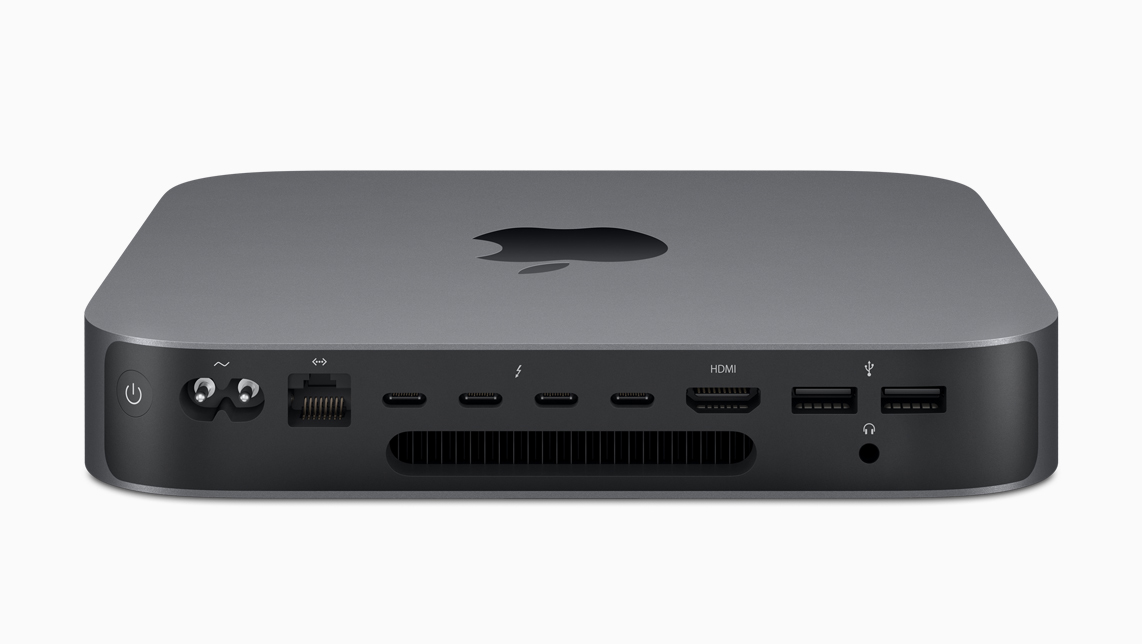Tim Cook introduced the new Mac mini at the Brooklyn Academy of Music’s Howard Gilman Opera House by gesturing to the sky. What followed was a video titled ‘The Arrival’ depicting a Mac mini descending like a UFO from the nighttime sky into the desert, which turned out to be a nighttime wallpaper from Mojave, Apple’s latest macOS update. It was a fun introduction to a computer that was last updated in 2014, and many Mac users had predicted would be discontinued.
As rumored, the new Mac mini is distinguishable from its predecessors by its new Space Gray color. The size is the same as previous models, but there are new ports on the rear and an entirely different set of components and layout inside. The new model is a little heavier too, coming in at 2.9 pounds, whereas prior models were either 2.6 or 2.7 pounds depending on the configuration. The new mini is also quieter rated at 4dBA when idle as compared to 12dBA for the older version and made from 100% recycled aluminum.
Apple’s latest mini can be configured with 4 or 6 CPU cores. The 4-core model includes 3.6GHz quad-core Intel Core i3 CPUs with 6MB shared L3 cache and the 6-core model featuring 3.0GHz 6-core Intel Core i5 with Turbo Boost up to 4.1GHz and 9MB shared L3 cache. Both models can be upgraded to a 3.2GHz 6-core Intel Core i7 with Turbo Boost up to 4.6GHz and 12MB shared L3 cache. According to Apple’s presentation, the new CPUs are up to 5x faster than before.
The new models also include Apple’s custom T2 chip. That adds Apple’s Secure Enclave coprocessor and allows for secure booting and encrypted storage. It also means fast HEVC video transcoding.
The base models of both minis start at 8GB of 2666MHz DDR4 SO-DIMM RAM but can be configured in 16GB, 32GB, or 64GB. Storage options have been significantly increased too. The base model of the 4-core mini features a 128GB of SSD storage, while the 6-core model starts at 256GB. Both SSD configurations can do 3.4GB/sec sequential reads. The 4-core model can be upgraded to 256GB, 512GB, 1TB, or 2TB of SSD storage and the 6-core model to 512GB, 1TB, or 2TB of SSD storage. Apple says the SSDs are up to 4 times faster than prior models.
Graphics for both minis are powered by an Intel UHD Graphics 630, which Apple says is up to 60% faster than before. The new mini can power two or three 4K and 5K displays depending on their configuration. According to Apple’s technical specifications, the mini supports:
- Two displays with 4096-by-2304 resolution at 60Hz connected via Thunderbolt 3 plus one display with 4096-by-2160 resolution at 60Hz connected via HDMI 2.0; or
- One display with 5120-by-2880 resolution at 60Hz connected via Thunderbolt 3 plus one display with 4096-by-2160 resolution at 60Hz connected via HDMI 2.0.
As with past models, the mini also includes a healthy number of ports including:
- 4 Thunderbolt 3/USB-C
- 2 USB-A 3
- HDMI 2.0
- 3.5mm audio out
- Gigabit Ethernet configurable to 10GB Ethernet
The mini also supports 802.11ac WiFi networking and Bluetooth 5.0.
To keep the mini cool, Apple has redesigned the power supply, added a bigger fan, and expanded vents increasing airflow twofold.
To demonstrate the power of the new mini’s, Apple’s website includes statistics about how much faster the machines can perform tasks in popular Apple and third-party pro apps including Xcode, Logic Pro X, Final Cut Pro X, Pixelmator Pro, Adobe Photoshop CC, Autodesk Maya, and others. The numbers are impressive, but it’s worth keeping in mind how old the prior Mac minis had become when evaluating the speed increases.
The base configurations of the mini start at $799 and $1099 respectively and can be ordered today for delivery November 7th.

As demonstrated in the hands-on area of today’s event, the diminutive mini can be stacked for uses like build and render farms.
Mark Gurman of Bloomberg raised the prospect of a ‘pro’ Mac mini back in August. That’s led to two months of speculation about what a pro mini might mean for users. It also meant that after four years of waiting, expectations were high going into today’s event.
Overall, Apple seems to have delivered. We’ll need to see how these new computers compare on benchmarks against others in Apple’s lineup, but they are entering the market at a higher spot than the last generation models did, which should please many users.
Still, for the mini to remain a viable alternative long term, Apple needs to update it more often than once every four years. Hopefully, with the new internal design, the company has the headroom to make that happen.
You can also follow all of our Apple event coverage through our October 30, 2018 hub, or subscribe to the dedicated October 30, 2018 RSS feed.






